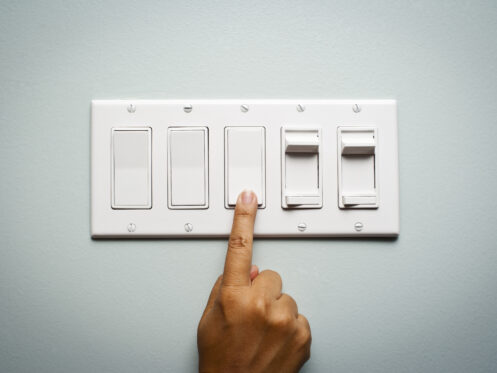Whether you’re remodeling your existing home or building a new one, you have many different elements to consider. One of the most important is lighting as it not only brightens up your space but promotes a specific ambience for each room. If you’re in the process of deciding on new lighting solutions, be sure to keep energy efficiency in mind.
What Are Energy-Efficient Lighting Solutions?
It’s been suggested by the U.S. Department of Energy (DOE) that the average homeowner spends about 15% of their total electricity costs on household lighting. In an effort to help reduce electricity consumption, new energy-efficient lighting solutions have been presented in the public marketplace. These come in the form of LED lighting, timers, dimmers, CFL lighting, and other ENERGY STAR products. The more efficient the lighting products that you use in your household are, the more money you’ll be able to save each year on your electricity bills.
LED Lighting
LED lighting, known formally as light-emitting diode, is a solid-state type of lighting technology that was traditionally used for traffic and indicator lights. However, the fact that they use up to 90% less energy and last 25 times longer than traditional incandescent lighting has made them one of the most popular lighting types of the market today.
LED is now available in all different forms of lighting. There are bulb replacements for 40, 50, 60, and even 100-watt light bulbs. There are reflector bulbs, task lighting, track lighting, undercabinet lighting, recessed lighting, outdoor lighting, pathway lighting, step lighting, and so many others. While LED lights are more costly than traditional incandescent lights, their prices keep coming down year after year as they gain in popularity.
CFL Lighting
CFL, known formally as compact fluorescent lighting, is a type of lighting structure that relies on the presence of an electrical current being sent through a tube filled with argon and mercury vapors. The current creates ultraviolet lighting that’s invisible to the naked eye. So a phosphor coating over the bulb’s surface is necessary to cause the current to emit visible light.
CFLs typically take longer to get up to their optimal brightness, taking about 30 seconds up to 3 full minutes. However, once at optimal lighting capacity, CFL lights use 70% less energy than incandescent lights. CFL bulbs can last up to 10 times longer than incandescent bulbs.
Timers
A light timer can be a great addition to your home lighting system that can automatically help reduce your energy usage. A light timer is an electrical circuit that has a built-in clock. You simply input your settings for when you want the light to be on and off. The timer will take care of killing power to your light source at times you have designated for the light to be off.
Timers can be integrated into many different lighting fixtures throughout your home. One of the more common locations is for your outdoor lighting fixtures. These lights are helpful to have on for certain hours of the evening. But, they can be simply wasteful when run for hours when you don’t need them. Consider installing a timer for your outdoor lights to turn them off after a set time, like midnight.
Dimmers
Dimmers provide variable indoor lighting for various light fixtures and can be controlled manually, with timers, or even with sensors. Every time a light bulb is dimmed, its wattage and output is reduced. This allows you to use less energy to power the bulb and extend the overall useful lifespan of the bulb.
It’s very important to note that you’ll need to purchase CFLs and LEDs that are compatible with dimmers as not all bulbs are. Dimmers can be used in a wide variety of applications throughout your home, including living rooms, bedrooms, and so forth.
Motion Sensors
Motion sensors work to detect when there’s occupancy and will turn on a lighting fixture. The fixture will remain on for a short while and will eventually shut off to conserve energy. Motion sensors are ideal for outdoor lighting as well as security lighting fixtures. It’s vital to note that most homeowners use motion sensors during nighttime applications.
You’ll need to purchase a sensor that has an additional photosensor. This will detect when there’s light outside and stop the light from turning on. This makes the most sense for the instance of outdoor lighting. You likely don’t want your outdoor flood light to turn on during the daytime when you’re walking through your yard. Rather, you only want it to turn on at night when you walk across your yard.
A Note on ENERGY STAR Ratings
Lighting fixtures that receive the ENERGY STAR rating have undergone adequate testing to verify their delivery of brightness and energy savings. Typically, light bulbs that have an ENERGY STAR rating are going to use between 70 and 90% less energy and create 70% less heat than incandescent bulbs. ENERGY STAR-rated bulbs will last between 10 to 25 times longer and can save you up to $80 per bulb.
Occupancy Sensors
Another useful tool for any energy-efficient household lighting setup is an occupancy sensor. These work somewhat similarly to motion sensors with some notable variations. Occupancy sensors use either infrared technology to detect heat and motion or ultrasonic sensors to detect sound. When the sensor detects that someone is in the room or area the sensors are positioned in, they will trigger the lights to turn on.
This can be useful in a wide variety of applications, including task lighting. For example, having occupancy sensors hooked up to your undercabinet lighting will allow the lights to automatically turn on when you’re working under the cabinet area. Then, the sensors will shut off the lighting after there’s no occupancy detected for a predetermined amount of time.
Photosensors
As we addressed a little bit earlier, photosensor lights are responsible for detecting when ambient lighting is present. Whenever there is ambient lighting, photosensors will automatically prevent the lighting fixtures they’re wired to from turning on. These photosensors are great for outdoor lighting where you don’t need to have your lighting fixtures on at any point where there’s natural sunlight.
Planning an Energy-Efficient Lighting Setup For Your Home
As a homeowner, the prospect of saving money on your annual electric bills can be quite desirable. Whether you’re remodeling a particular room or your entire home, you’ll want to take some time to plan out an energy-efficient lighting scheme. It’s easiest to start with determining where your new lighting fixtures will be and what their main usages will be. Then, start going over the list of devices above, like photosensors, dimmers, occupancy sensors, timers, and motion sensors, to determine if any of them can be particularly useful for each lighting application.
Expert Interior Lighting Installation Service
General Air Conditioning & Plumbing offers expert interior lighting installation service to the Palm Springs, CA community. We can also assist with all your heating, air conditioning, plumbing, electrical, and drain service needs. Call us today to schedule a new service consultation.


